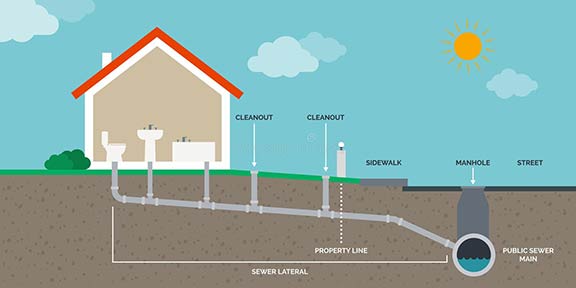You know your home has connections to a sewer system. The wastewater that comes from your home has to be going somewhere, and that place is not within your yard. But beyond this and the fact that there is an underground sewer line running from your home to the public sewer system, what else do you know about your home’s sewer system.
Most property owners know surprisingly little about how the various systems in their homes work, says East Bay Property Management. When they take the time to learn about the function of one of the building’s systems, the sewer system is often the last one they choose to educate themselves. Yet the sewer system is easily the most important in a house for keeping the home sanitary.
Knowing how your sewer system works will help you understand your home better and improve your ability to maintain it. It will make it easier to understand some of the obscure terms your plumber uses when explaining plumbing issues to you. Knowing how the sewer system works will also satisfy your curiosity about what happens after you flush the toilet.
Types of Wastewater Systems
Every time you wash your hand in the sink or flush your toilet, you create wastewater (known more correctly as sewage). Instead of the ground around your home or a nearby stream, this wastewater is channeled away from your property. There are three main reasons for this:
- Unpleasant odors: Sewage has a strong foul odor that people find highly repulsive. Releasing sewage into the soil around the home or streams would make it hard to live on the property. Also, it would destroy the water in that stream.
- Presence of harmful bacteria: Sewage contains harmful bacteria which can cause diseases if people come into contact with them. Releasing sewage into the ground around the home or nearby streams will let these harmful organisms find their way into the communal drinking water.
- Dangerous chemicals and solids: Wastewater contains nitrogen and phosphates. These elements encourage algal bloom that disrupts marine ecosystems. The bacteria in wastewater will also deprive fish of oxygen. Furthermore, the solid materials in wastewater will pollute streams and make them murky.
Septic tanks
Houses in rural areas have what is called a septic tank. These are large concrete or steel tanks buried near the home. Wastewater is channeled into the septic tank, where it is held until its contents decompose naturally. Septic tanks can hold up to 1,000 gallons of water. They are the preferred method for treating wastewater in these regions. That is because homes are so widely dispersed that a central sewer system would be too costly to install.
Urban wastewater systems
Urban areas use a centralized sewer system; wastewater from all the homes in the community is collected and channeled to a municipal wastewater treatment facility. Most homes have two separate sewer lines: a sanitary sewer and a storm sewer.
- The sanitary sewer carries wastewater from the home to the city wastewater treatment.
- The storm sewer takes the water (rain and snow) outside your house, bypasses the wastewater treatment to a stream, river, or lake.
- The storm sewer may also connect to the sanitary sewer to create what is known as a combined sewer system.
Here is how the three systems work:
Sanitary sewers
Here is how sanitary sewers work:
- When the toilet in your home is flushed, or you wash dishes in the kitchen sink, the wastewater flows through small pipes into your home’s sewer line.
- The sewer lines in your home are only large enough to carry human waste and toilet paper. They transport the wastewater out of your property into the sewer main in the street.
- The sewer main moves this content until it reaches the wastewater treatment plant, where it is stripped of pollutants.
- The treated water is then returned to the environment.
- This system operates under the force of gravity, but in low-lying areas, pumps may be helpful.
Storm sewers
These carry rainwater or melting snow from roads and roofs and transport the water to nearby water bodies. Here is how they work:
- When it rains or when the snow melts, the water flows over the ground until it enters a storm sewer through a ditch, manhole, pipe, or storm drain inlet.
- This wastewater bypasses the wastewater treatment plant. It is not treated but is carried directly to a stream or river.
Combined sewers
Here, a single pipe transports wastewater and storm runoff water. In combined sewer systems, all the contents of the sewer pipes go to the wastewater treatment plant. In the dry season, when the volume of stormwater is low, this does not pose a problem. But in the wet season, water quantity in the systems may be so much that some will flow into rivers and streams. Combined sewer systems are not very efficient.
